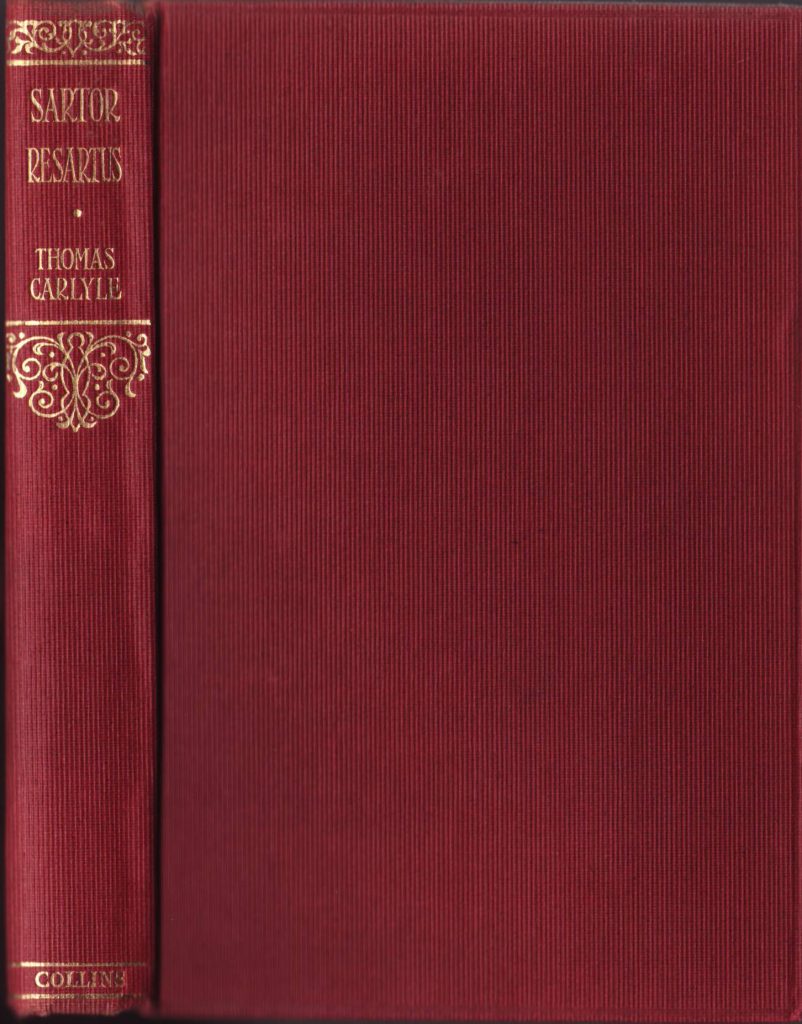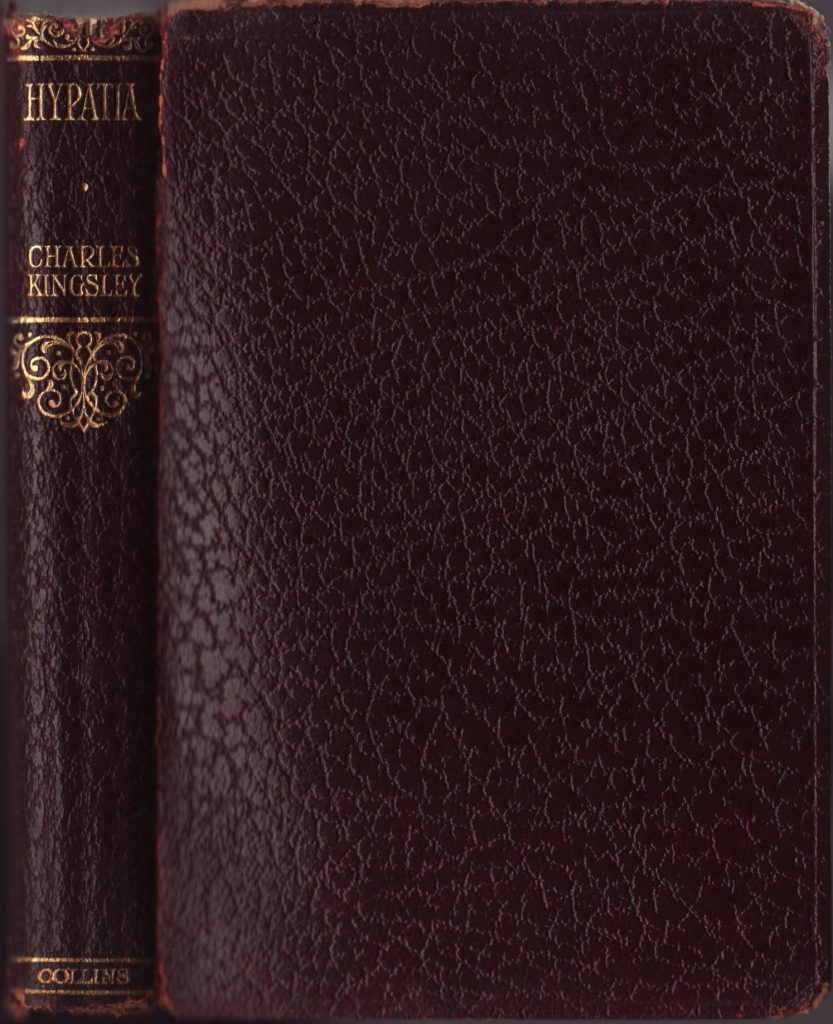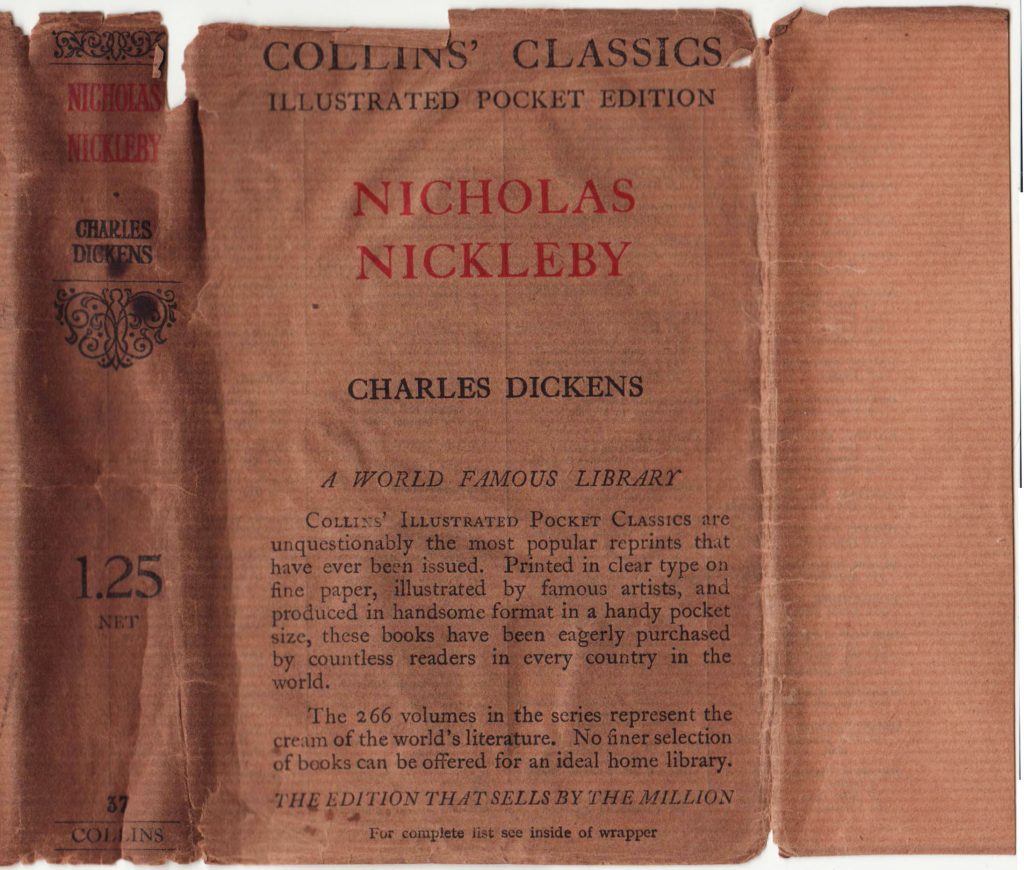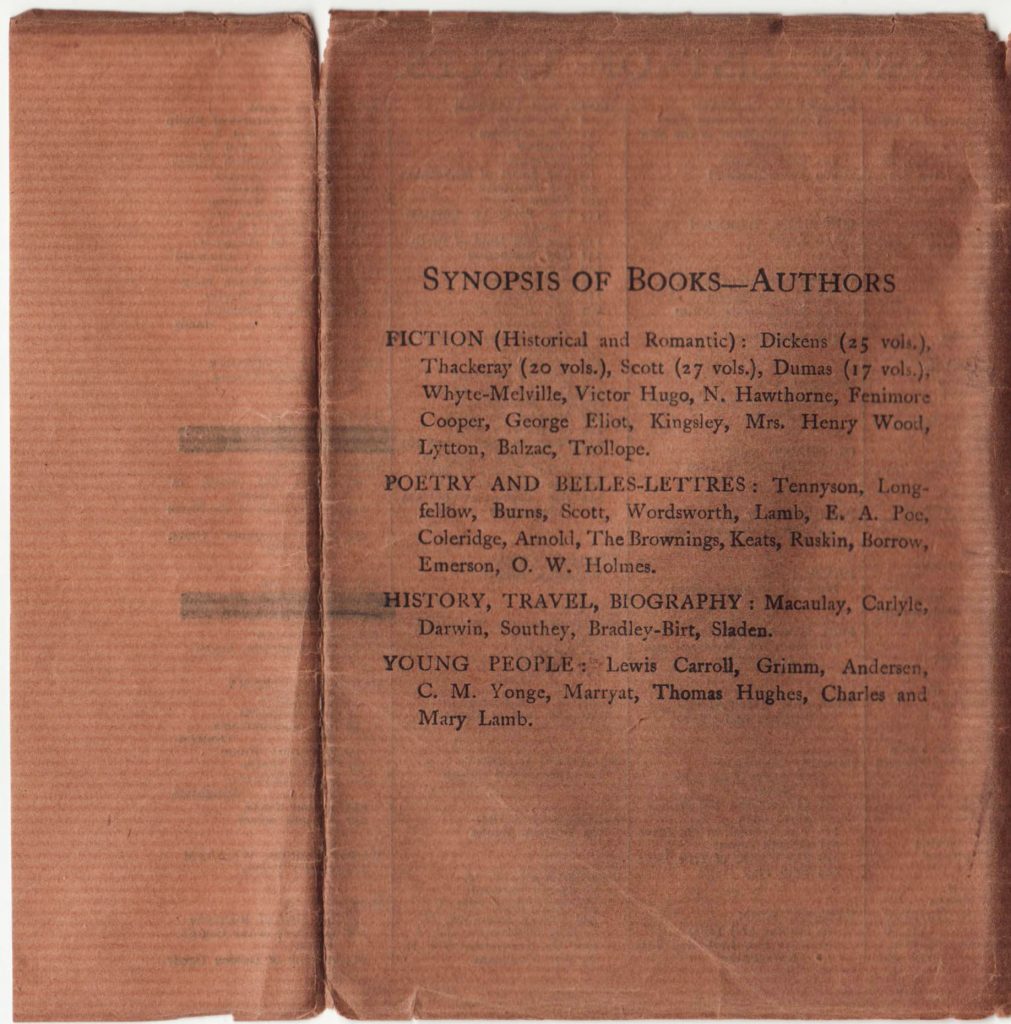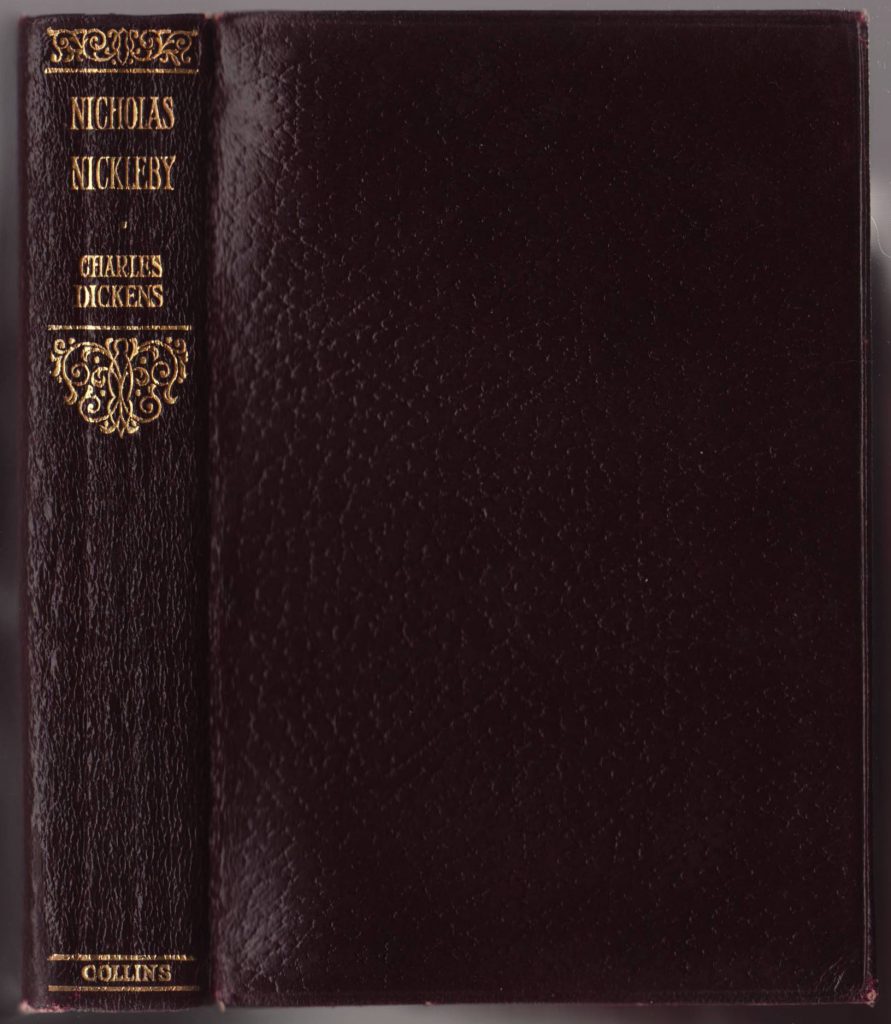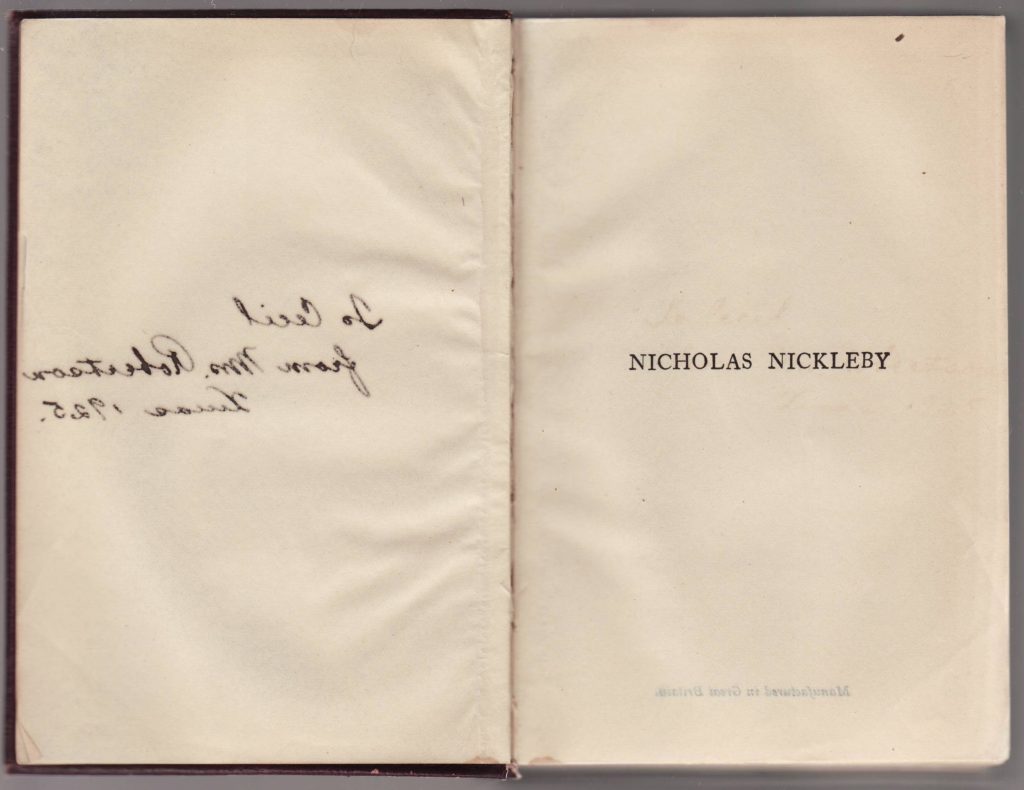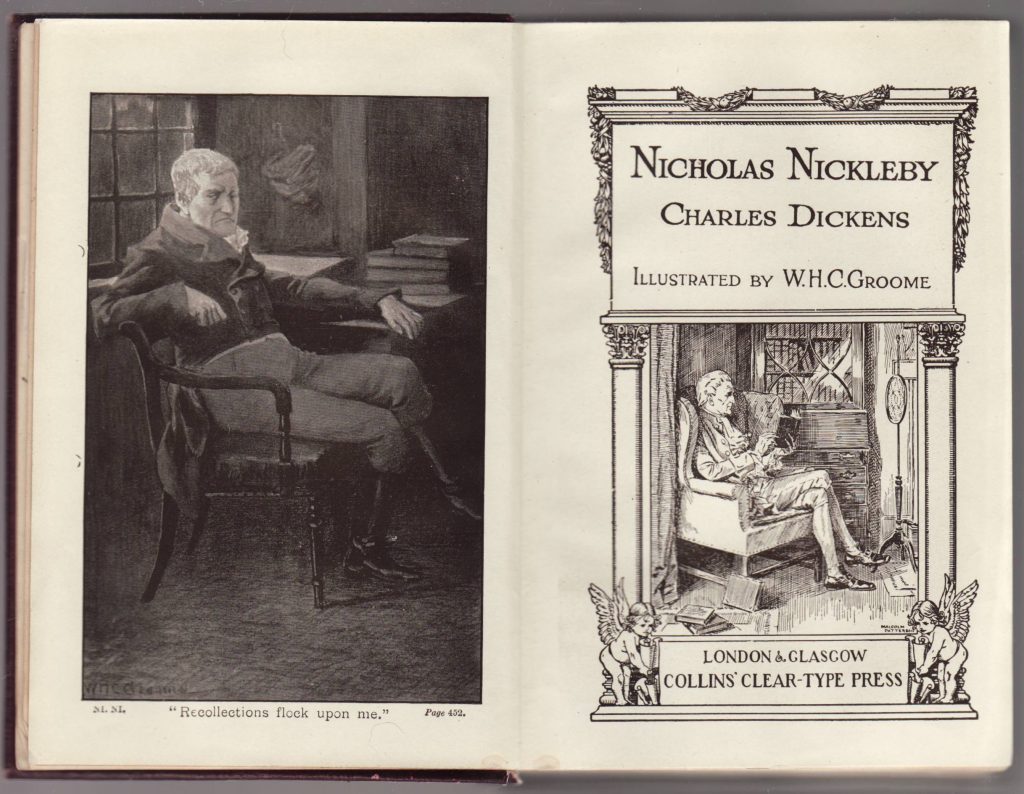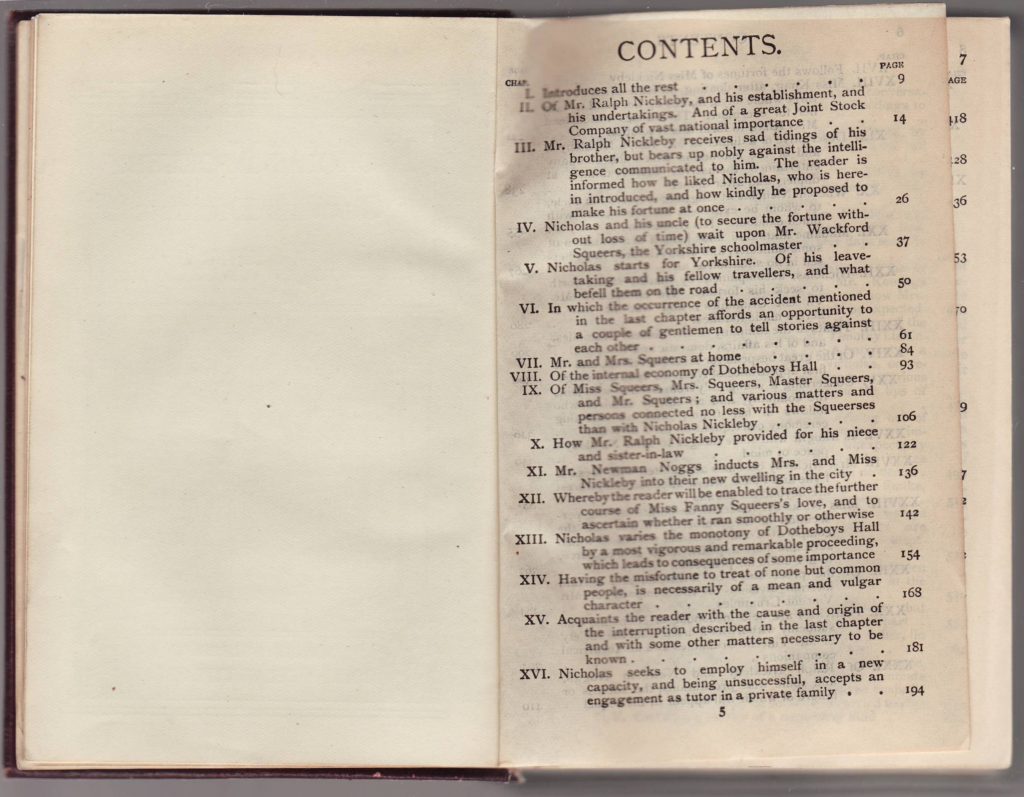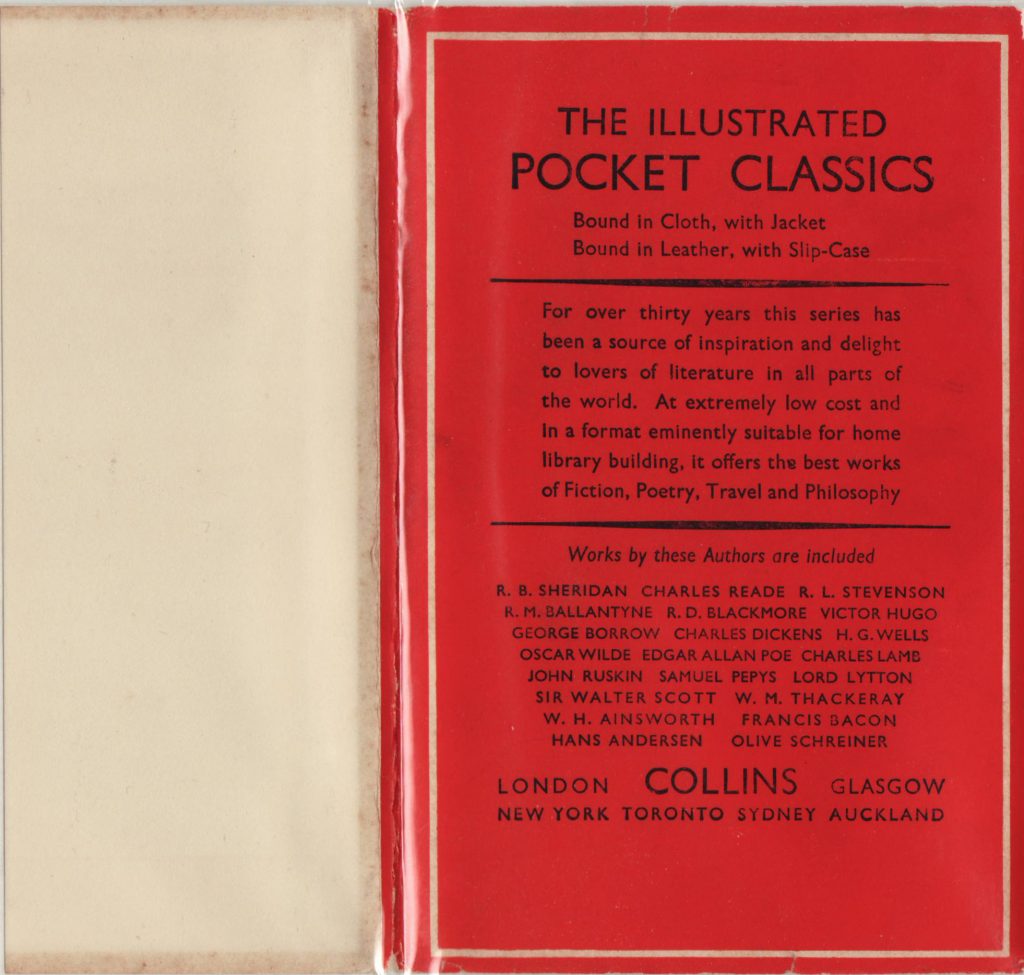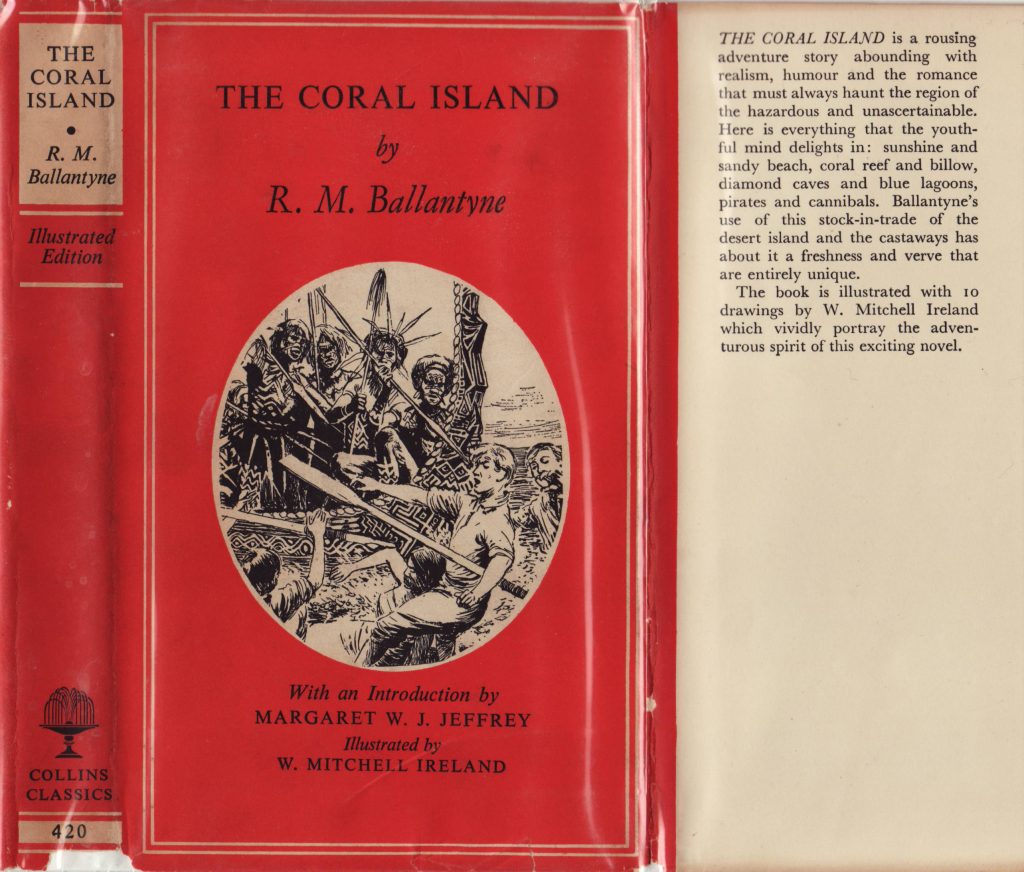aka/ Collins’ Classics Illustrated Pocket Edition
aka/ Collins’ Handy Illustrated Pocket Novels
aka/ Collins’ Illustrated Pocket Classics
aka/ Collins’ Pocket Classics
aka/ Collins’ Library of Classics
aka/ Collins’ New Classics(1953-1970)
William Collins & Sons (aka/ Collins Clear-Type Press) (London, Glasgow, UK)
Series dates: 1903-1945; 1953-1970
Size: 4″ x 6″ (1903-1945), 4.5″ x 7.25″ (1953-1970)
William Collins & Sons of Glasgow & London, founded in 1819, produced reprint series under some variation of the Collins’ Classics name throughout most of the 20th century. In the first half of the century, 50,000,000 copies of Collins’ Classics books were sold. The number of titles reached to around 500 by the 1950s. Despite variations in the series name, this is one coherent series published over much of the 20th century. The earlier titles in the series (1903-1945) are small (4″ x 6″) and of decent quality (typography, paper, and bindings). Collins sold books through their American office (opened in 1904 and closed in 1905), and then through the John C. Winston Co. (who acquired the Collins stock after Collins closed their American branch). Winston possibly sold Collins’ Classics titles in the US after that date.
The series was relaunched in the 1950s in a larger size (4.5″ x 7.25″) with reset typography and the addition of more scholarly apparatus (index, bibliography, etc.) suggesting Collins was aiming at the course text market. The titles were sold in the US in cooperation with W.W. Norton & Co.
Collins’ Classics series was first published in the fall of 1903 under the unwieldy moniker Collins’ Handy Illustrated Pocket Novels. The series was promoted as the only illustrated cheap classics series on the market. 80,000 copies of the first 10 titles were sold in the first 6 months. 50 volumes were available by the fall of 1905, and by 1906 sales had reached over 400,000. That year the series name was adjusted to Collins’ Illustrated Pocket Classics, and the series would carry on under some variation of that name until 1970. 100 titles had been issued by 1908. To improve sales, Collins had copies placed in the rooms of many hotels in the UK with the name of a local bookseller stamped on the cover. The series had 320 titles in 1934, as more contemporary authors (many who appeared in other earlier modern literature reprint series published by Collins) were included in the series. (series data from David Keir, The House of Collins, London: Collins, 1952).
The earliest books I have from the series are difficult to date specifically but probably 1906-1915. Someone with a bit of time could compile the number of titles listed on these early jackets and, comparing to advertisements for titles in the series, construct a sequence of jackets with dates of approximate publication.
Series jackets are common in design with the author and title, along with the series number, printed on the jackets. Price (2/6) is printed on the front of the jacket. An oval was left blank on the spine for the price. In this case, a sticker (2/-) with the series name is affixed indicating a price change. Titles in the series are listed on the jacket flaps and back.
Titles, continuing from the front flap, are listed on the rear flap and back of the jacket. The series has 248 titles at this time, dating the book to roughly 1910-1915.
A selling point of the series is the illustrations, which are scattered through the book. Typically, there are about a half-dozen illustrations but sometimes fewer (as in Sartor Resartus, which has but one, an illustration of the author facing the title page).
Bindings are a relatively sturdy cloth, with gold stamping. There is no indication of the series in the books except if a catalog is printed at the end of a title (which it was not in all cases).
A typical catalog in the back of some titles indicates books in the series (248) and the availability of a leather-bound version of the books.
A modification to the jacket design was made a year or so after the jacket above was issued. Notice the blank oval on the jacket spine for a price. There are 286 titles on this jacket, placing it a few years after the jacket above, possibly 1912-1915. The red printing on the jackets was probably eliminated to save money – thus jackets with the red and black jackets are most likely earlier editions.
An example of the leather binding, available for 5/- net.
William Collins & Sons opened an American branch at 23 East 20th Street in New York in 1904 (Publishers Weekly, July 2, 1904). While this effort seemed to be successful (suggested by a move to a larger warehouse at 27 East 21st Street was announced in Publishers Weekly, January 7, 1905) the branch was closed later that year. The entire stock of Collins’ American branch was acquired by the John C. Winston Co. (Publishers Weekly, December 16, 1905).
An August 25, 1906, issue of The Publishers’ Circular and Booksellers’ Record indicated that a promotional copy of Collins’ new edition of Dickens’ Nicholas Nickleby (illustrated by W.H.C. Groome) had been received. I believe the copy of Nicholas Nickleby below is the same edition, thus dating it to around 1906. Interestingly, the jacket spine is imprinted with a $1.25 price, indicating this title was sold in the U.S. I am also assuming that Winston was selling these titles in the US, and possibly continued selling them (given the sheer number of these books from the 1920s and 1930s in the U.S. someone was distributing them in the U.S.).
The jackets are common to the series and both the UK and US jacket designs were similar. In this case, the design on the jacket spine mimics the design on the book spine, and the price is indicated on the spine. On this U.S. jacket, a blurb for the series (“A World Famous Library”) fills the lower half of the front of the jacket. This differs from the “synopsis” of titles on the UK titles above. I’ll make a guess that this style of jacket was meant to sell the series to a new audience in the U.S., and it probably mimics the earliest (1903-1904) jackets on series titles sold in the U.K. A statement guides the viewer to see the inside of the dust jacket for a list of the 266 titles in the series. The front flap is blank. The jacket is printed on a crinkly kraft paper with distinctive ridges. The red and black printing probably dates this book to slightly before the Kingsley book directly above. In general, the jacket and book design of early Collins’ Classics resemble Winston’s Handy Classics titles, suggesting this was a jacket and book sold by Winston for the U.S. market.
The reverse of the jacket contains a synopsis of books and authors in the series, arranged by four categories: Fiction; Poetry and Belles-Lettres; History, Travel, Biography; and Young People. The rear flap is also blank.
The reverse of the dust jacket contains a list of the 266 titles in the series, organized by author’s name. The book (or at least the jacket) was probably issued in the 1912-1915 time frame. A few titles – Twain and Lew Wallace – are blacked out. Collins had the UK rights to these American authors, but apparently not the US rights. Twain’s works would remain under Harper’s control until the late 1930s.
The faux leatherette is sturdy and in this case in excellent shape more than a century after the book was made. The gold stamping and designs are only on the book spine.
The half-title page:
The reverse of the half-title page includes “Manufactured in Great Britain.” These books were printed and bound in the UK and shipped to the US, where the jackets were (probably) printed.
One of the illustrations in the book faces the illustrated title page.
The copyright page is blank.
The book was printed at the Collins Clear-Type Press, London, and Glasgow.
With title lists over 300 volumes, Collins redesigned the series jackets in full color, revealing the growing importance of the dust jacket as advertising for the book. A portrait of the author is included on the jacket spine and a color illustration from the book used on the cover. Series number (#1 below) along with the price (2/-) is included on the spine. Jacket flaps indicate the latest titles added to the series. No dates are to be found anywhere, but these probably date from around 1920.
A creative innovation for the jacket back is to include advertising. All the copies I have (10) save one include a color Waterman’s Pen ad. The one exception (below) is a series advertisement.
A series advertisement on the back of one jacket, and additional Waterman’s Pen advertisements. The ads could recoup some of the cost of printing the color jackets, which were important for selling the series.
The interior of the jacket contains a full list of titles at the time of the jacket’s printing. Click to enlarge.
While not as lurid as some color jackets of the era (Reader’s Library, for example) Collins still tried to grab buyer’s attention with dramatic scenes from the books on the jacket covers. These illustrations are both an interesting interpretation, by the publisher, of key scenes in the book, but also an indication of what they thought would sell the book.
As with other series (such as the Borzoi Pocket Books) the depression and economic slump of the 1930s led to the scaling back of the design of 1920s era series jackets and bindings. Collins replaced the dramatic jackets with simpler, commonly designed jackets.
The rear of the jacket promotes the series, indicating that leather-bound copies come with a slipcase. There is no list of titles on the jacket or its reverse.
Bindings are similar to the earlier cloth bindings. There is still no mention of the series inside, but now Library of Classics on the title page.
In the early 1950s, Collins Classics were redesigned and reissued as the Collins New Classics Series. The titles were similar to the earlier series, with new titles that expanded the series to around 500 by the end of the 1950s. Illustrations remained part of the identity of the series. Some jackets reproduced illustrations from the book. Jacket flaps contained a summary of the book. Series numbers are included on the base of the jacket spine. The jacket below is from a 1953 book.
The back includes a list of some of the authors in the series. There is no catalog in the book or on the jacket. Even though the serial numbering continued to build on the pre-WW2 list of titles, it is unlikely that more than a few hundred titles maximum were reissued in the New series.
The rear flap contains a summary of what is new about the revised series, including the increase in book size, more legible text, more careful editing, new introductions, bibliographies and author biographical information. All these developments suggest a refocusing of the intended audience for the books – university courses.

Some titles have a commonly designed, plain jacket with no illustrations. This is a book from 1955:

The rear of the Boswell title includes an advertisement for a few additional titles in the new series. Also of interest is the sticker at the bottom of the jacket: Collins had entered a partnership with W.W. Norton to sell Collins New Classic Series in the US along with the Norton Library and other Norton college texts.

Bindings are sturdy, gold stamped cloth. The leather binding option is not mentioned and most likely not part of the New series.

Title pages of New Classic Series books from the 1950s include revised publisher information glued to the title page showing both Collins and Norton as the publisher. These were undoubtedly books printed in the UK and sold in the US by Norton.
A slip is tucked into one of the UK copies with an invitation to mail Collins for a list of New Classics titles. The front and rear of the slip of paper are below.
Collins also packaged some New Classics titles for the tourist trade, such as Borrow’s Wild Wales below. The jackets were different from the normal series and these titles sometimes included additional illustrations and photographs. This copy is from 1955.
The latest printings of this revised Collins series are in 1970. This is also around the time that the Modern Library and Everyman’s Library began to phase out their hard covered, smaller format books. Competition from cheaper paperbacks is one potential explanation for these large, long-term series dying out around the same time.




